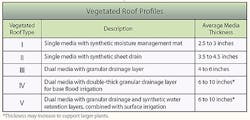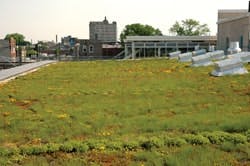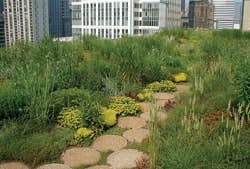Vegetated roofs - often described as green roofs, living roofs, or ecoroofs - are surging in popularity. Well-designed
vegetated roofs provide advantages beyond the typical insulation and watertightness qualities of a non-vegetated roof. They are remarkable "green machines" that can cool cities, reduce stormwater runoff, improve runoff quality, increase open space, extend overall roof life, and reduce cooling costs. Vegetated roofs can be spectacular rooftop amenity spaces that increase a building's market value and appeal, too.
From the base up, a vegetated roof generally comprises a root barrier (if necessary) and a water retention/drainage layer separated from the growing media above by a thin filter fabric, and then is topped with plant material and wind-erosion protection. Vegetated roofs can be installed over any type of roof deck and on top of nearly any type of waterproofing. Typically, vegetated roofs up to 6-inches deep are characterized as extensive, while the thicker vegetated roofs are intensive. The vast majority of vegetated roofs can be classified into one of five classifications. Generally, these types are distinguished by thickness with Types I, II, and III representing the thin, extensive vegetated roofs; Types IV and V represent the intensive profiles. Finally, for most vegetated roof projects, rigorous stormwater and energy simulations can be conducted to evaluate opportunities to reduce other on-ground stormwater measures and the HVAC system size.
Vegetated roofs are often designed for the minimal weight and cost to satisfy local regulations or to qualify for local government incentives. These thin, lightweight vegetated roofs are not typically visible from the ground and are often only accessible by maintenance crews. Temperate climates can support thin, relatively inexpensive vegetated roofs that would otherwise die in subtropical and warmer, arid climates. Vegetated roofs satisfying this project profile are almost always Type I or Type II, which utilize a moisture-management mat or a sheet drain, respectively, under 3 to 4 inches of growing media. These vegetated roofs are usually un-irrigated and require minimal maintenance (about 2 to 3 hours per 1,000 square feet per year). Type I and Type II profiles are established primarily with sedums, an incredibly hardy perennial succulent groundcover. In temperate climates, Type II, with 4 inches of growing media, is the most ubiquitous extensive vegetated roof.
Artfully landscaped amenity roof spaces typically include at least some intensive vegetated roof areas. In general, the thicker the vegetated roof, the more varied the plant palette it can support. Irrigation may also be introduced, and pavers or paved areas, vine screens, and hardscape elements may be incorporated into the overall design.
Types III, IV, and V constitute the vegetated roof profiles used for these dramatic, accessible roofscapes. The profiles that most closely mimic nature, Types III and IV, are dual-media profiles without any synthetic retention or drainage sheets; the granular drainage media and the growing media retain the appropriate amount of moisture for the system. (Type V profiles include a synthetic retention sheet under the granular media layer.) Types III and IV also integrate well to allow seamless transitions across different profile thicknesses. Finally, these two profiles uniquely accommodate base-level irrigation, which delivers water at the root level (as opposed to surface spray or drip), minimizing direct evaporation and many maintenance concerns.
Vegetated roofs offer a powerful value proposition, attractive both to developers and owners, and to governments and agencies. Since the American vegetated roof industry is still young, working with knowledgeable, qualified design teams; requiring vegetated roof specifications to be compliant with ASTM standards and testing methodologies; and limiting installations to experienced crews are all worthwhile, cost-conscious initiatives that can lay the groundwork for a successful vegetated roof project.
Melissa Muroff is principal at Philadelphia-based Roofscapes Inc. (www.roofmeadow.com).





